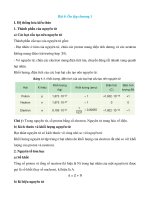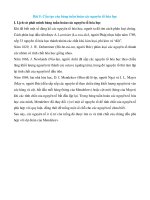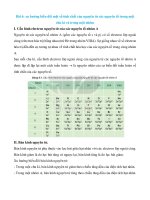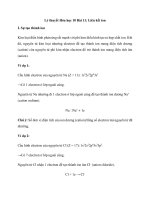Kế hoạch bài dạy tiếng anh 7 bộ sách i learn smart world (kì 2) ILSW
Bạn đang xem bản rút gọn của tài liệu. Xem và tải ngay bản đầy đủ của tài liệu tại đây (35.95 MB, 457 trang )
School:
………………………………………..
Date:……………………………..
Class: ……………………………..........
Period: ………………………......
UNIT 6: EDUCATION
Lesson 1.1 – Vocabulary and Listening (page 44)
I. OBJECTIVES
By the end of the lesson, Ss will be able to:
1.1. Language knowledge and skills
- know more words relating to school tasks and school activities (essay, project,
homework, book report, test, presentation).
- talk about things they have to do at school.
- listen to and understand a conversation of two students trying to make plans (for
general and specific details).
- know how to decline an invitation.
1.2. Competences
- improve communication, collaboration, and critical thinking skills.
1.3. Attributes
- love school and schooling.
- have a balance between studying and relaxing.
II. TEACHING AIDS AND LEARNING MATERIALS
1. Teacher’s aids: Student book and Teacher’s book, class CDs, Digital Book (DCR
phần mềm tương tác SB, DHA (từ vựng/ cấu trúc) phần mềm trò chơi tương tác),
projector/interactive whiteboard / TV (if any), PowerPoint slides.
2. Students’ aids: Student’s book, workbook, notebook.
III. ASSESSMENT EVIDENCE
1
Performance Tasks
Performance
Products
Assessment Tools
- Match the words with the
descriptions.
- Ss’ answers.
- T’s feedback/Peers’
feedback.
- Listen and repeat.
- Ss’ presentation.
- T’s feedback/Peers’
feedback.
- Say which things you have - Ss’ presentation.
to do at school.
- T’s feedback/Peers’
feedback.
- Listen to two students
trying to make plans. Who
is busier?
- Ss’ answers.
- T’s feedback/Peers’
feedback.
- Listen and fill in the
blanks.
- Ss’ answers.
- T’s feedback/Peers’
feedback.
- Speak: Does your life
sound more like Alan's or
Lucy's? Why?
- Ss’ answers/
presentation.
- T’s observation and
feedback.
IV. PROCEDURES
A. Warm up: (5’)
a) Objective: Introduce the new lesson and set the scene for Ss to acquire new
language; get students' attention at the beginning of the class by enjoyable and short
activities as well as to engage them in the follow-up steps.
b) Content: Introduce words about school tasks / Introduce the new topic:
Education.
c) Expected outcomes: Ss get to know some new words they are going to study
in the lesson.
d) Organization of the activity:
TEACHER’S ACTIVITIES
STUDENTS’ ACTIVITIES
Option 1: Match the words with the
descriptions. Listen and repeat.
- Use the “New words” part a – page 44 for the
2
warm-up activity.
- Show words and definitions using DCR, have
Ss look and match the words with the
descriptions (in pairs).
- Work in pairs to match the words
with the descriptions.
- Call Ss to give answers.
- Give feedback and show correct answers using
DCR.
- Give answers.
- Lead to the new lesson.
- Play the audio (CD1 – Track 58), have Ss
listen and repeat.
- Listen.
- Correct Ss’ pronunciation if necessary.
- Listen and repeat.
Answer keys
Option 2: Letter Lingo.
- Show 9 pictures.
- Have Ss give name of each picture (randomly)
and use the red and underlined letter of each
answer to form a new English word.
- The first S to give the right key word will be
the winner.
3
- Take part in the class’s activity.
- Give answers.
- Lead to the new lesson.
- Listen.
*Illustration:
Answer key
Key word: Education
B. New lesson (35’)
Activity 1: Pre-Listening (Vocabulary) (12’)
a) Objective: Ss get to know words about school tasks.
b) Content:
- Vocabulary study (essay, project, homework, book report, test, presentation).
- Speaking: Say which things you have to do at school.
c) Expected outcomes: Ss know how to pronounce the new words correctly and use
them when talking about school tasks.
d) Organization of the activity:
TEACHER’S ACTIVITIES
STUDENTS’ ACTIVITIES
Task a. Match the words with the
descriptions. Listen and repeat.
Option 1 (If the teacher hasn’t used this
part for the Warm-up activity)
- Demonstrate the activity on DCR, using the
example.
- Look and listen.
- Work individually.
- Have Ss match the words with the
descriptions.
- Divide class into pairs and have them check
their answers with their partners.
- Call Ss to give answers.
4
- Work in pairs.
- Give answers.
- Check answers as a whole class using DCR.
- Listen and repeat.
- Play audio (CD1 – Track 58). Have Ss listen
and repeat.
Answer keys
- Correct Ss’ pronunciation.
Option 2: (If the teacher has used part a.
for the Warm-up activity.)
- Work in pairs.
- Give some pictures, have Ss look and give
- Give answers, meaning.
names of the pictures, using new words in
Task a. (T uses different pictures from those in
Task a.)
- Have Ss give answers and tell the meaning of - Read.
words / phrases again.
- Check answers as a whole class.
Answer keys
- Call some Ss to read the words again.
- Correct Ss’ pronunciation if necessary.
1 test
2 essay
3 homework
4 presentation
5 book report
6 project
5
Task b. In pairs: Say which things you have
to do at school.
- Have Ss work in pairs to say which things
they have to do at school.
- Go round and give help if necessary.
- Have some pairs demonstrate the activity in
front of the class.
- Give feedback and evaluation.
- Work in pairs.
- Present.
Sample answers
Activity 2: While - Listening (17’)
a) Objective: Students can develop their listening skill.
b) Content:
- Listen to two students trying to make plans. Who is busier?
- Listen and fill in the blanks.
c) Expected outcomes: Students can listen and understand general and specific
information about trying to make plans.
d) Organization of the activity:
TEACHER’S ACTIVITIES
STUDENTS’ ACTIVITIES
Task a. Listen to two students trying to
make plans. Who is busier?
- Have Ss read the question, guess the
6
answer.
-Work individually.
- Play audio (CD1 - Track 59).
- Listen.
- Have Ss listen and circle the correct
answer.
- Circle the correct answers.
Answer keys
- Check answer as a whole class using
DCR.
- Read, underline the key words.
Task b. Now, listen and fill in the blanks.
- Have Ss read the through the content of
Task b, underline the key words.
- Do the task.
- Exchange answers.
- Play the audio again (CD1 - Track 59).
Answer keys
- Have Ss listen and fill in the blanks.
- Have Ss check answers with their
partners.
- Call Ss to give answers.
- Give feedback and show correct answers
using DCR.
7
Activity 3: Post - Listening (6’)
a) Objective: Students can use the vocabulary and the content in listening part to
develop their speaking skill.
b) Content: Speaking: Does your life sound more like Alan's or Lucy's? Why?
c) Expected outcomes: Students can express their own ideas about school life and
activities after school.
d) Organization of the activity:
TEACHER’S ACTIVITIES
STUDENTS’ ACTIVITIES
Conversation skill
- Have Ss look at the Conversation skill box
and read.
- Look and read.
- Play audio (CD 1 - Track 60) using DCR,
have Ss listen and repeat.
- Listen and repeat.
- Ask Ss to find more ways to decline an
invitation.
- Give answers.
Task c. In pairs: Does your life sound
more like Alan's or Lucy's? Why?
- Have Ss work in pairs to discuss.
- Observe and give help if necessary.
- Call some pairs to share their ideas with the
class.
- Give feedback and evaluation.
- Work in pairs.
8
- Present.
C. Consolidation and homework assignments (5’)
* Consolidation:
- Words relating to school tasks and school activities. (essay, project, homework,
book report, test, presentation).
- Language to ask for declining an invitation: Thanks, but I’m sorry I can’t / Thanks
a lot, but I’m sorry, I have to …
* Homework
- Learn the new words by heart.
- Practice talking about things you have to do at school.
- Do the exercises in WB: New words and Listening (pages 32, 33).
- Do the vocabulary exercise in Tiếng Anh 7 i-Learn Smart World Notebook (page 36).
- Play consolation games in Tiếng Anh 7 i-Learn Smart World DHA App on
www.eduhome.com.vn
- Prepare: Lesson 1.2 – Grammar (page 45 – SB).
D. Reflection
a. What I liked most about this lesson today:
…………………………………………………………………………………
………
b. What I learned from this lesson today:
…………………………………………………………………………………
………
c. What I should improve for this lesson next time:
9
…………………………………………………………………………………
………
School:
………………………………………..
Date:…………………………………..
Class:
…………………………….....................
Period: ………………………….........
UNIT 6: EDUCATION
Lesson 1.2 - Grammar (page 45)
10
I. OBJECTIVES
By the end of the lesson, Ss will be able to:
1.1. Language knowledge and skills
- listen to 2 people asking and answering about making a plan.
- use “have to”, “has to” for obligation expression.
- talk about things they have to / don’t have to do at home or at school.
1.2. Competences
- improve speaking, listening skills.
- improve the use of English.
1.3. Attributes
- be responsible for school work and housework.
- have a balance between studying and relaxing.
II. TEACHING AIDS AND LEARNING MATERIALS
1. Teacher’s aids: Student book and Teacher’s book, class CDs, Digital Book (DCR
phần mềm tương tác SB, DHA (từ vựng/ cấu trúc) phần mềm trò chơi tương tác),
projector/interactive whiteboard / TV (if any), PowerPoint slides, handouts.
2. Students’ aids: Student’s book, workbook, notebook, handouts.
III. ASSESSMENT EVIDENCE
Performance Tasks
Performance Products
Assessment Tools
- Listen and repeat.
- Ss’ performance.
- T’s feedback.
- Write sentences with
have to using the prompts.
- Ss’ answers.
- T’s feedback/Peers’
feedback.
- Fill in the blanks with
have to, has to, don't have
to, or doesn't have to.
- Ss’ answers.
- T’s feedback/Peers’
feedback.
- Speak: What things
do/don't you have to do at
home or at school?
- Ss’ answers/
presentation.
- T’s observation, T’s
feedback/Peers’ feedback.
11
IV. PROCEDURES
A. Warm up: (5’)
a) Objective: Introduce the new lesson and set the scene for Ss to acquire new
language; get students' attention at the beginning of the class by enjoyable and short
activities as well as to engage them in the follow-up steps.
b) Content: Review words about school tasks.
c) Expected outcomes: Ss review old vocabularies which are very useful for
them in the new lesson.
d) Organization of the activity:
TEACHER’S ACTIVITIES
STUDENTS’ ACTIVITIES
Option 1: Phone code
- Have Ss close books and notebooks.
- Close books and notebooks.
- Have Ss look at the phone code and write the
correct words.
- Work in pairs.
- Call Ss to give answers.
- Give answers.
- Check Ss’ answers, give feedback.
*Codes:
Answers keys
1. 33 7777 7777 2 999
1. essay
2. 8 33 7777 8
2. test
3. 44 666 6 33 9 666 777 55
3. homework
4. 7 777 666 5 33 222 8
4. project
5. 44 2 888 33 8 666
5. have to
12
- Make sentences.
- Have Ss make sentences, using the words they
have just made.
- Lead to the new lesson.
Option 2: Matching
- Close books and notebooks.
- Have Ss close all books and notebooks.
- Have Ss do the matching activity.
- Work in pairs to match.
- Call Ss to give answers, tell the meaning of
the phrases again.
- give answers, tell the meaning of the
phrases.
- Check Ss’ answers, give feedback.
- Listen and write the new lesson.
- Lead to the new lesson.
*Illustration
Answers keys
1. write: an essay, a book report
2. do: a project, a test, homework
13
3. take: a test
4. make: a presentation
5. have: a project, an essay, a book
report, a test, homework, a
presentation
B. New lesson (35’)
Activity 1: Presentation (10’)
a) Objective: Introduce: “have to” and “has to”.
b) Content:
- Listen and repeat.
- Introduce the grammar points.
c) Expected outcomes: Ss know the new grammar points (“have to” and “has to”) and
use them in some exercises that follow.
d) Organization of the activity:
TEACHER’S ACTIVITIES
STUDENTS’ ACTIVITIES
Task a. Listen and repeat
- Have Ss look at the picture using DCR.
- Look.
- Play audio (CD1 – Track 61) and have Ss
listen and read the speech bubbles.
- Listen, then read.
- Play the audio again and have Ss listen and
repeat.
- Listen and repeat.
Grammar box
Option 1:
- Have Ss look at the grammar explanation
and read.
- Look and read.
14
- Have Ss look at the box and read examples
of different forms.
- Read examples of different forms.
- Explain more about “have to”, “has to” to
express obligation.
- Ask Ss to make more sentences using “have
to”, “has to” to express obligation.
- Give feedback and evaluation.
Option 2:
- Listen.
- Have Ss look at the sentences in the speech
bubbles in Task a and read them again.
- Give more examples.
- Look and read.
15
- Have Ss make comments on the verb in bold.
- Give feedback.
- Have Ss look at the examples, read and
answer the question: Does teacher often ask
you to do these activities at school?
- Comment.
- Then, lead to the grammar box, briefly
explain the way to use “have to” and “has
to”.
- Have Ss read the grammar box again.
- Ask Ss to make more sentences using “have
to”, “has to” to express obligation.
16
- Give feedback and evaluation.
- Read.
- Give more examples.
- Listen.
Activity 2: Practice (19’)
a) Objective: Students can use “have to”, “has to” to do the given exercises.
b) Content:
- Write sentences with have to using the prompts.
- Fill in the blanks with have to, has to, don't have to, or doesn't have to.
c) Expected outcomes: Students can get used to the form and usage of use “have to”,
“has to” and use them correctly.
d) Organization of the activity:
TEACHER’S ACTIVITIES
STUDENTS’ ACTIVITIES
Task b. Write sentences with “have to”
using the prompts.
17
- Demonstrate the activity on DCR, using the
example.
- Look and listen.
- Have Ss write sentences with “have to”
using the prompts.
- Work individually.
- Have Ss work in pairs to check each other’s
work.
- Write answers.
- Have some Ss share their answers with the
whole class.
- Work in pairs.
Answer keys
- Give feedback, correct Ss’ answers if
necessary.
Task c. Fill in the blanks with have to, has
to, don't have to, or doesn't have to.
- Look and listen.
- Demonstrate the activity on DCR using the
example.
- Work individually.
- Have students fill in the blanks with have
to, has to, don't have to, or doesn't have to.
- Work in pairs.
- Have pairs check each other's work.
- Read answers, explain.
- Have some students share their answers
with the class.
Answer keys
Activity 3: Production (6’)
18
a) Objective: Students master the grammar points they study in the lesson.
b) Content: Speaking: What things do/don't you have to do at home or at school?
c) Expected outcomes: Ss produce the new language successfully, and they can use
the grammar point in the lesson in everyday speaking and writing.
d) Organization of the activity:
TEACHER’S ACTIVITIES
STUDENTS’ ACTIVITIES
Task d. In pairs: What things do/don't you
have to do at home or at school?
- Divide class into pairs.
- Have Ss take turns asking their partner
about what things do/don't they have to do at
home or at school?
- Have conversation in pairs.
- Have some pairs demonstrate the activity in
- Present.
front of the class.
- Listen.
- Give feedback and evaluation.
Suggested answers
C. Consolidation and homework assignments (5’)
* Consolidation:
19
* Homework:
- Make 4 sentences using have to / has to / don’t have to / doesn’t have to.
- Do the exercises in WB: Grammar (page 33).
- Complete the grammar notes in Tiếng Anh 7 i-Learn Smart World Notebook (page
37).
- Play consolation games in Tiếng Anh 7 i-Learn Smart World DHA App on
www.eduhome.com.vn
- Prepare: Lesson 1.3 – Pronunciation and Speaking (page 46 – SB).
D. Reflection
a. What I liked most about this lesson today:
…………………………………………………………………………………
………
c. What I learned from this lesson today:
…………………………………………………………………………………
………
c. What I should improve for this lesson next time:
…………………………………………………………………………………
………
20
School:
………………………………………..
Date:
…………………………………..
Class:
…………………………….....................
Period:
………………………….........
UNIT 6: EDUCATION
Lesson 1.3 – Pronunciation and Speaking (page 46)
I. OBJECTIVES
By the end of the lesson, Ss will be able to:
1.1. Language knowledge and skills
- distinguish and use sound changes of “…have to…” correctly.
- give thanks and decline an invitation.
- make plans.
1.2. Competences
- improve listening and speaking skills.
1.3. Attributes
- be responsible for school work and housework.
- have a balance between studying and relaxing.
II. TEACHING AIDS AND LEARNING MATERIALS
1. Teacher’s aids: Student book and Teacher’s book, class CDs, Digital Book (DCR
phần mềm tương tác SB, DHA (từ vựng/ cấu trúc) phần mềm trò chơi tương tác),
projector/interactive whiteboard / TV (if any), PowerPoint slides, handouts.
21
2. Students’ aids: Student’s book, workbook, notebook.
III. ASSESSMENT EVIDENCE
Performance Tasks
Performance
Products
Assessment Tools
- Listen to the sound
changes of the underlined
words.
- Ss’ performance and
answers.
- T’s observation.
- Listen and cross out the
sentence that doesn’t
follow the note in “a”.
- Ss’ answers.
- T’s feedback/Peers’
feedback.
- Read the sentences with
the sound changes noted in
“a” with a partner.
- Ss’ performance.
- T’s feedback/Peers’
feedback.
- Ask and answer.
- Ss’ performance.
- T’s feedback/Peers’
feedback.
- Practice with your own
ideas.
- Ss’ performance.
- T’s feedback/Peers’
feedback.
- Make plans with your
- Ss’ performance /
classmate. In pairs: Student Presentation.
B, turn to page 119, File 4.
Student A, write the
activities you want to do
and invite Student B to join
you. Swap roles and repeat.
Student A, turn to page
120, File 5 Did you draw
your partner’s kitchen
correctly?
- T’s observation, T’s
feedback/Peers’ feedback.
- Decide a time to meet.
- T’s feedback/Peers’
feedback.
- Ss’ answers.
IV. PROCEDURES
22
A. Warm up: (5’)
a) Objective: Introduce the new lesson and set the scene for Ss to acquire new
language; get students' attention at the beginning of the class by enjoyable and short
activities as well as to engage them in the follow-up steps.
b) Content: Introduce: have to / Review vocabularies about school tasks.
c) Expected outcomes: Ss remember old knowledge and use them in other
speaking activities.
d) Organization of the activity:
TEACHER’S ACTIVITIES
STUDENTS’ ACTIVITIES
Option 1:
- Have Ss close all books.
- Work in pairs, then give answers.
- Show 4 sentences with a blank inside each.
- Have Ss read these uncompleted sentences and
think of a word / phrase that can be filled in all
4 sentences.
- Call Ss to give answers.
Answer keys
The missing word / phrase: have to
- Give feedback and show correct answer.
- Lead to the new lesson: The sound changes in
“have to”.
*Suggested sentences:
1. I _____do my essay.
2. I _____give a presentation tomorrow.
3. I _____do my math homework tonight.
4. I _____write a book review next week.
Option 2: Review vocabularies about
school tasks
- Close books.
- Have Ss close all books.
- Give Ss 6 sets of words. Each set contains 3 to
23
- Work in groups of 3-4 and guess
4 subordinating words.
key words.
- Have Ss use the words given to guess key
words.
Answer keys
1. mid-term, multiple choice,
speaking: TEST
- Call Ss to give answers.
- Give feedback.
2. characters, author, plot: BOOK
REVIEW
- Lead to the new lesson.
3. speech, confidence, body
language: PRESENTATION
*Illustration:
1. mid-term, multiple choice, speaking
4. team work, deadline, meeting:
PROJECT
2. characters, author, plot
3. speech, confidence, body language
5. literature, paragraph, thesis
statement: ESSAY
4. team work, deadline, meeting
5. literature, paragraph, thesis statement
6. math, extra exercises, after school:
HOMEWORK
6. math, extra exercises, after school
B. New lesson (35’)
Activity 1: Pre-Speaking: Pronunciation (8’)
a) Objective: Introduce sound changes of “have to”.
b) Content:
- recognize sound changes of “have to”.
- listen and check, find the sentence that doesn’t follow the note in “a”.
- practice.
c) Expected outcomes: Ss distinguish and use sound changes of “have to” correctly in
their speaking.
d) Organization of the activity:
TEACHER’S ACTIVITIES
STUDENTS’ ACTIVITIES
Task a + b. Listen to the sound changes and
focus on the underlined words.
- Play the recording (CD1, track 62).
- Listen.
24
- Ask Ss to listen and focus on the sound
changes of the underlined words.
- Play the recording again, have Ss listen and
repeat with a focus on the pronunciation
feature.
- Listen again and repeat.
Task c + d. Listen and cross out the
sentence that doesn’t follow the note in “a”.
- Play the recording (CD 1 – Track 63), have
Ss listen and cross out the option that doesn’t
follow the note in “a”.
- Call Ss to give answers.
- Play the recording again and check answers
as a whole class using DCR.
- Listen and give answers.
Answer keys
- Give feedback and evaluation.
Activity 2: While-speaking (22’)
a) Objective: Students can give thanks and decline an invitation.
b) Content:
- Ask and answer, then practice with your own ideas.
- Make plans with your classmate. In pairs: Student B, turn to page 119, File 4. Student
A, write the activities you want to do and invite Student B to join you. Swap roles and
repeat. Student A, turn to page 120, File 5 Did you draw your partner’s kitchen
correctly?
c) Expected outcomes: Ss produce the new language successfully.
d) Organization of the activity:
TEACHER’S ACTIVITIES
STUDENTS’ ACTIVITIES
PRACTICE
25









